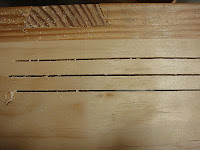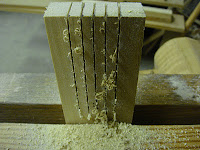This past Saturday, the newly formed Chesapeake Chapter of the Society of American Period Furniture Makers (
SAPFM) held it's second meeting in Harrisburg, Pennsylvania. As this chapter has members from a wide geographic area, we try to have meetings in a variety of locations as to try to be fair to everyone. This meeting was quite some distance from my house; more than a three hour drive, but the first meeting was so good that I really didn't want to miss the second. It did not disappoint.
The meeting started out with a little bit of chapter business and then it was on the the fun stuff. Member Fred Walker (chapter coordinator) had graciously offered to tutor members on building a Chippendale side chair and he was first up, discussing the style and construction techniques of the chair. I can't imagine too many people knowing more about these chairs than Fred. Mark Maleski (secretary/treasurer) then showed his progress on the chair that he was building under Fred's tutelage and discussed what he'd learned and his failures and successes. Impressive stuff to say the least.
Next up was show and tell, one of my favorite parts, where members can bring in things they've built or are in the process of building. There was a beautifully constructed 18th century style tea caddy, a stunning tiger maple keepsake box, and my personal favorite, a 17th century style joined stool ala Peter Follansbee/Jennie Alexander. I brought my new tool chest, Seaton chest inspired firmer chisels, 18th century style tenon saw, cross cut and rip panel saws (more on the rip panel saw in a future post). Judging by the number of questions I received, there seems to quite a bit of interest in tool making. Obviously, it's something that I thoroughly enjoy.
Then came our featured speaker for the meeting, Chuck Bender of the
Acanthus Workshop. Chuck is a master craftsman who has been building period furniture for over 30 years. In 2007 he started the Acanthus Workshop where he teaches a variety of classes to all skill level of woodworkers. The title of his presentation was The Good/Bad/Ugly-Design and Construction. One of the main objectives of the talk was to get us to recognize good design from bad. Chuck had put together a wonderful slide show featuring some beautiful period pieces, as well as some that just didn't quite measure up. This was an effective presentation as it really gave you a chance to see what visually worked on these pieces and what just did not, using not some golden rule formula, but just your natural sense of proportion and what looked right to the eye. I said earlier that I couldn't imagine too many people knowing more about Chippendale chairs than Fred Walker, well I'd say Chuck is one of those few who knows at least as much.
In addition to all this, the members of this chapter are fantastic. Just to name two, at this meeting were blogger's extraordinaire Kari Hultman of
The Village Carpenter blog and Shannon Rogers of
The Renaissance Woodworker blog and
The Hand Tool School. I had the opportunity to talk to both quite extensively and they are both great people. Kari is one of the most passionate woodworkers you'll ever meet and so talented in so many areas of woodworking. And she shares my love of toolmaking. :) Shannon educated me on different varieties of furniture wood and answered all my questions about the different varieties of mahogany on the market. He knows a LOT about lumber. (He works at McIlvain's Lumber)
I'm so glad that I was able to attend this meeting. It was well worth the drive. Although our chapter is in it's infancy, it's off to a wonderful start. Our first meeting's feature speaker was Kaare Loftheim, journeyman cabinet maker at Colonial Williamsburg. Kaare is one of my favorite people to learn from. He is knowledgable, talented, and has a wonderful sense of humor that make his presentations a lot of fun. Our third meeting is already set to take place at
McIlvain Lumber in the Baltimore suburbs with Don Williams scheduled to be our featured guest. Don is the Senior Furniture Conservator at the Smithsonian Institution's Center for Materials Research and Education. Don is a master at furniture refinishing amongst other things. He is the mastermind behind the Andre Roubo translation project and author of the upcoming book about H.O. Studley, of the famous Studley tool chest. Not a bad first three featured presenters! Thanks to Bert Bleckwenn (Chapter President) and all others who give of their time to make our meetings great. I encourage anyone interested in furniture making (or tool making) to come to our next meeting and check things out. You won't be disappointed.






















































